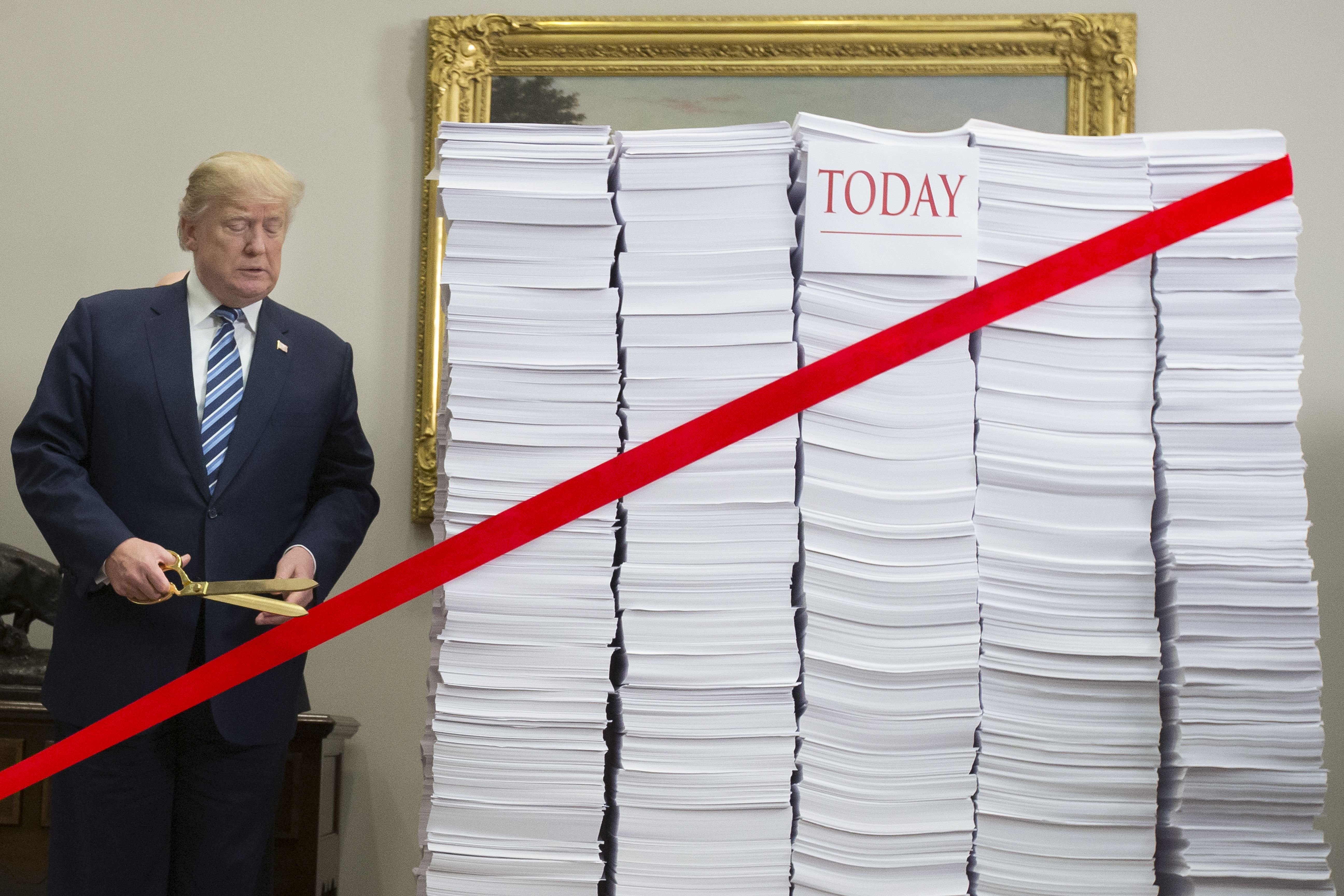The Great Rules Rollback – By The Editorial Board – December 25, 2017
Reining in regulation is a major success of Trump’s first year.
Amid the debate over tweets and tax reform, perhaps the most significant change brought by the first year of the Trump Presidency has been overlooked: reining in and rolling back the regulatory state at a pace faster than even Ronald Reagan. This is a major reason for the acceleration of animal spirits and faster economic growth in the past year.
A rules rollback is harder than it sounds because the inertial tendency of bureaucracies is to expand, and the modern administrative state has expanded almost inexorably under presidents of both parties. New rules are published in the Federal Register, and Barack Obama presided over six of the seven highest annual page counts ever. In 2016 his regulators left town with a record-breaking binge of 95,894 new pages, according to Wayne Crews, who tracks the administrative state for the Competitive Enterprise Institute.
George W. Bush wasn’t much better. His Administration added 79,435 pages in 2008, its most expansive regulatory year. By contrast in the first year of the Trump Presidency through Sept. 30, 45,678 pages were added to the Federal Register. Many were required to follow-up on legislation and rules from the Obama era, so the Trump trend is even better.
***
Ten days after his inauguration, Mr. Trump issued an executive order directing his departments to scour the books for rules they could rescind or repeal without damaging the law. He also directed that for each single regulation issued, agencies should identify at least two for elimination. In one his best appointments, he named Neomi Rao to run the White House Office of Information and Regulatory Affairs that must clear new rules.
The results have been impressive. Ms. Rao reported this month that through Sept. 30 the Trump Administration had taken 67 deregulatory actions but only three new significant regulatory actions. That’s a 22 to 1 ratio. She also reported that since fall 2016 more than 1,500 planned regulatory actions have been withdrawn or delayed. For fiscal 2018, the current agenda includes 448 deregulatory actions and 131 regulatory actions, a better than 3 to 1 ratio.
One reason for success is forcing agencies to abide by the Administrative Procedure Act, which outlines a public comment period for proper rule-making and which the Obama Administration routinely ignored. Last year Mr. Crews counted at least 480 Obama-issued executive orders and memoranda, and that’s not counting guidance, administrative interpretations and other bits of “regulatory dark matter” used to promulgate policy.
Democrats are now dismayed to learn that what can be done with the stroke of a pen can be undone. The Trump Administration has rescinded Education Department guidance on transgender bathrooms, as well as the 2011 “Dear Colleague” guidance that established kangaroo courts on campus to adjudicate sexual assault and harassment. It has negated Labor Department guidance that held businesses legally responsible for their franchisees’ wage-law violations, creating “enforcement traps waiting to spring,” in the words of the Chamber of Commerce.
Ms. Rao is also requiring agencies to submit an annual “regulatory budget.” In fiscal 2018 the budget target is a net reduction in regulatory costs. This has been a goal of regulatory watchdogs for years because it forces agencies to think twice about proposing new rules. And if they do, then they need to eliminate regulatory costs somewhere else. If enforced with rigor, this could be the most important check on the bureaucracy since FDR invented the modern administrative state.
Congress has also helped with unprecedented use of the Congressional Review Act (CRA) to nullify 14 Obama-era rules and one Consumer Financial Protection Bureau rule promulgated under Richard Cordray. The CRA had only been used once before, in 2001 to nix a late Bill Clinton rule.
The 2017 list includes a regulation that would have imposed onerous disclosure requirements on mining and drilling companies operating overseas, carrying $700 million in initial costs and up to $590 million for annual compliance. Congress also nixed rules on education, public land and the use of family-planning funds. By eliminating these 14 rules, lawmakers spared Americans from $3.7 billion in costs and eliminated 4.2 million hours of paperwork, says the American Action Forum.
***
The size of the economic impact of all this is hard to measure, though the Trump Administration projects the regulatory cost savings for the economy will be $9.8 billion over the next fiscal year. Mr. Crews has estimated that regulation took a $1.9 trillion annual toll on the economy last year.
But the far larger impact is lifting the pall of government hassle and arbitrary enforcement from business. In the Obama era, CEOs never knew when or how a federal agency might strike for political reasons, no matter the law. Simply lifting that constant fear has had a liberating effect on risk-taking and investment. The deregulation effort ranks with judicial confirmations and tax reform as the main Trump achievements of the year.
Source: The Great Rules Rollback
 Listen Online
Listen Online Watch Online
Watch Online Find a Station in Your Area
Find a Station in Your Area









 Listen Now
Listen Now Watch Online
Watch Online
